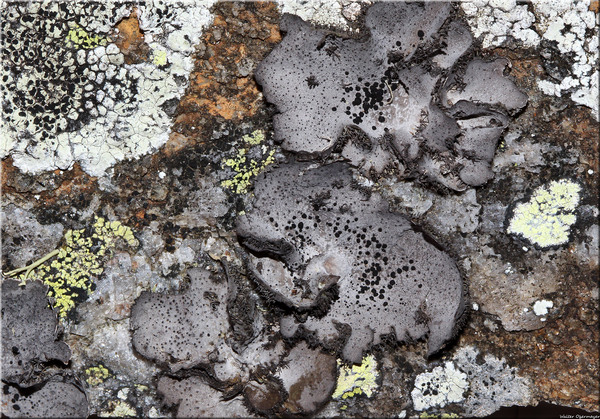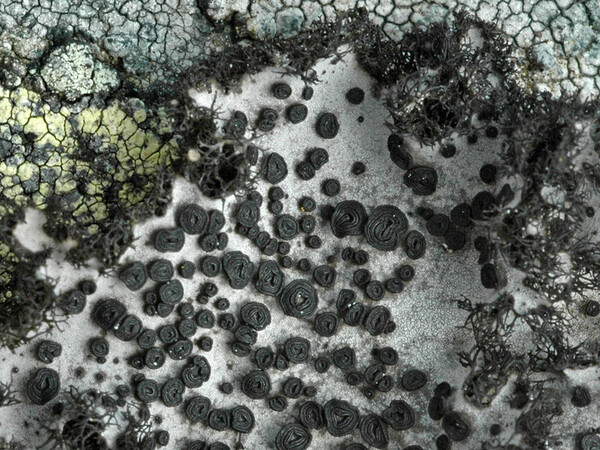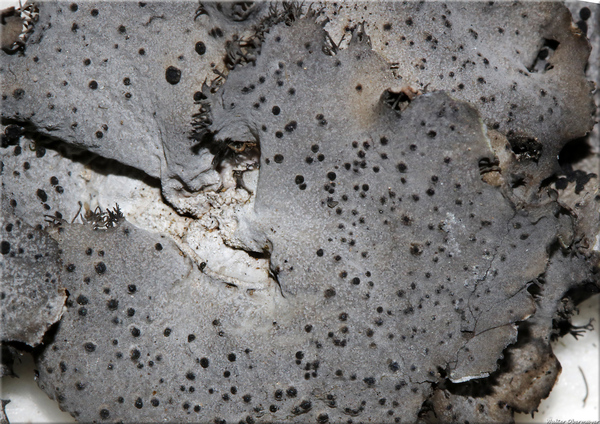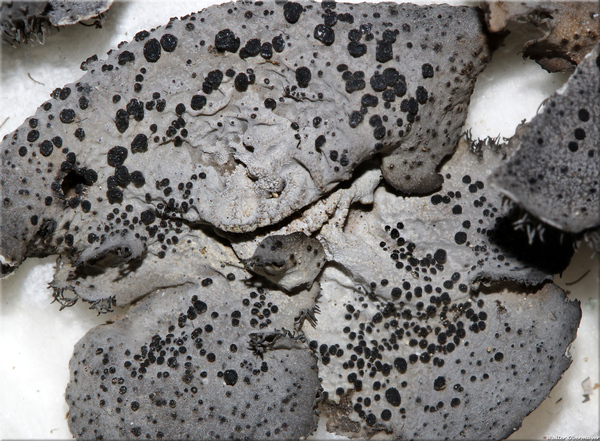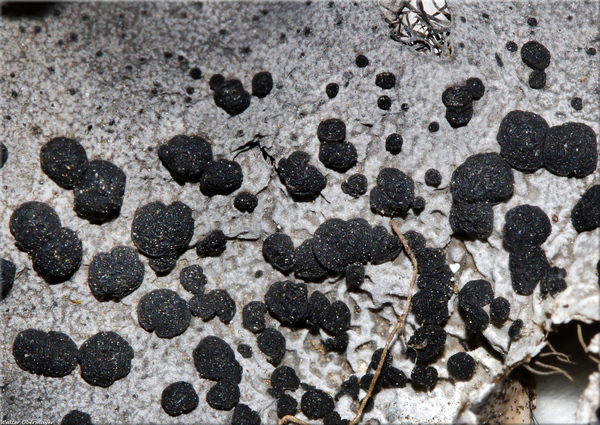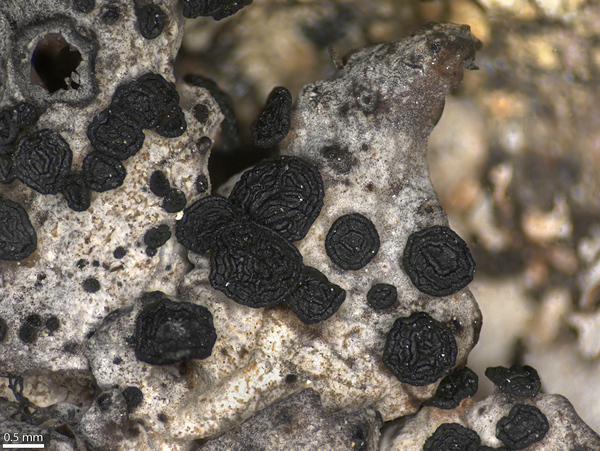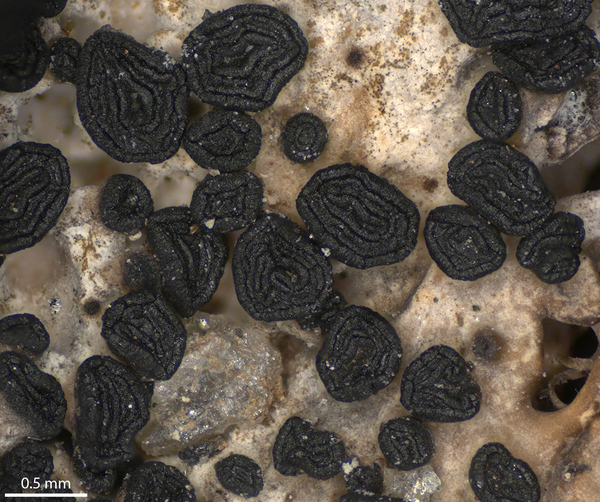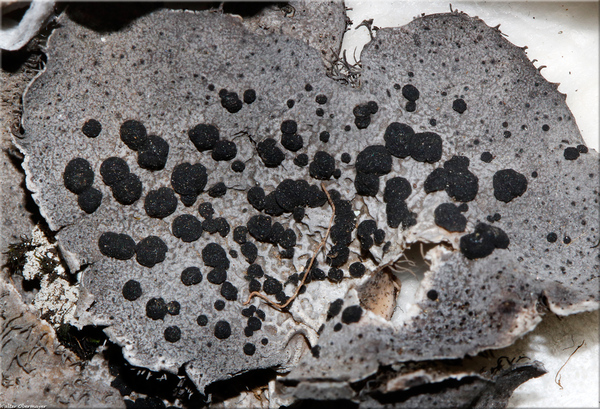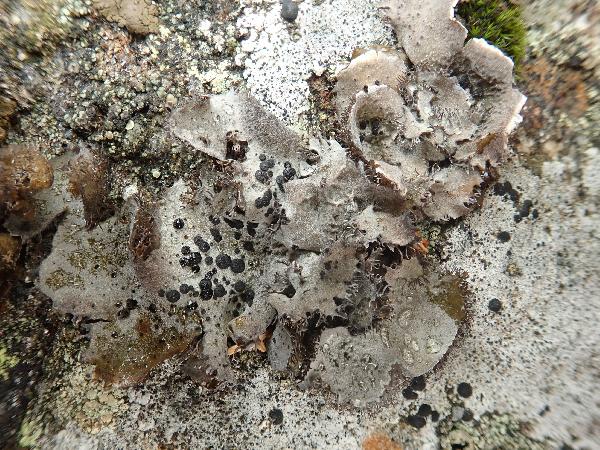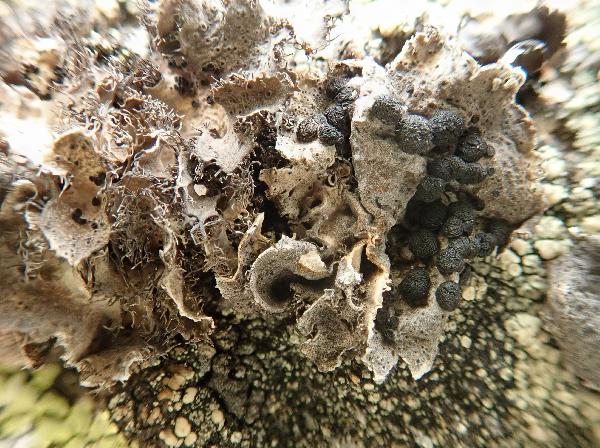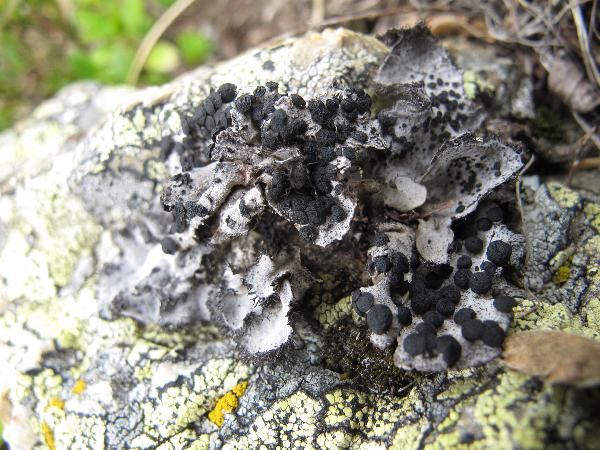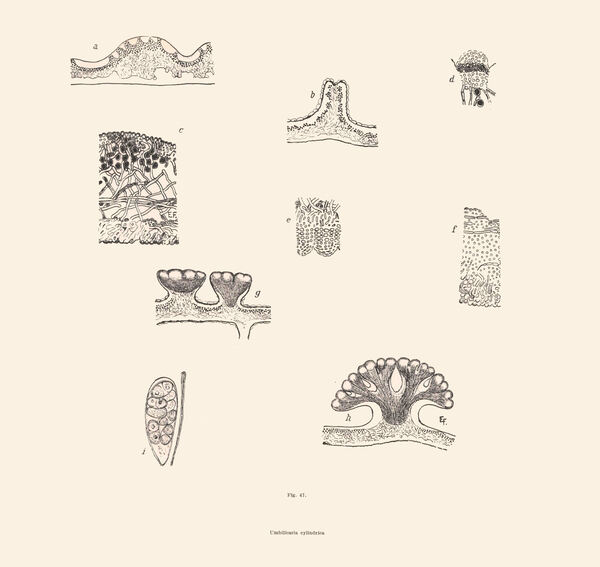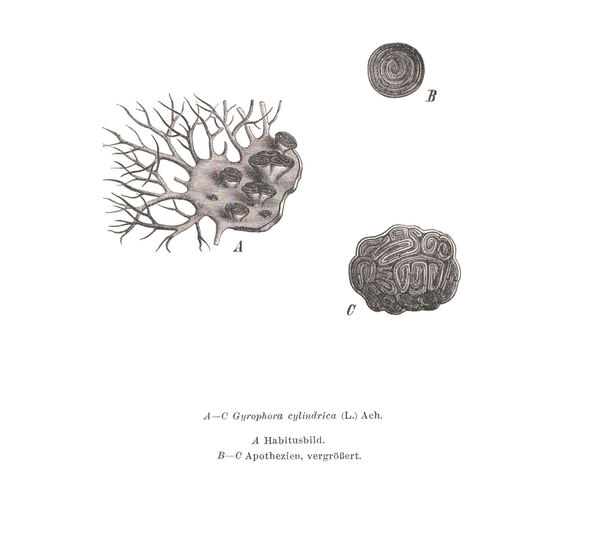Umbilicaria cylindrica (L.) Delise var. cylindrica
in Duby, Bot. Gall., 2: 595, 1830. Basionym: Lichen cylindricus L. - Sp. Pl., 2: 1144, 1753.
Synonyms: Gyrophora cylindrica (L.) Ach.; Gyrophora cylindrica var. nudiuscula (Schaer.) Flot.
Distribution: N - Frl (Tretiach & Hafellner 2000), Ven, TAA (Caniglia & al. 2002, Nascimbene 2003, 2006c, 2008b, Lang 2009, Nascimbene & al. 2022), Lomb (Rivellini 1994, Dalle Vedove & al. 2004, Brackel 2013, Gheza 2019, 2019b), Piem (Morisi & Sereno 1995, Isocrono & Falletti 1999, Isocrono & al. 2003, 2004, 2006, Morisi 2005, Isocrono & Piervittori 2008, Giordani & al. 2014, Favero-Longo & al. 2015, Lich. Ital. Exs. 39: Isocrono & al. 2020), VA (Borlandelli & al. 1996, Piervittori & Isocrono 1997, 1999, Piervittori & al. 1998, 2001, 2004, Valcuvia 2000, Isocrono & al. 2008, Favero-Longo & Piervittori 2009, Blisa & al. 2011, Matteucci & al. 2013b, 2015c, Watson 2014), Emil (Dalle Vedove & al. 2002, Fariselli & al. 2020), Lig (Brunialti & al. 1999). C - Tosc, Abr (Gheza & al. 2021), Sar. S - Bas (Potenza & al. 2014), Cal (Puntillo 1996, Potenza & al. 2011).
Description: Thallus foliose-umbilicate, heteromerous, dorsiventral, monophyllous, 3-5(-7) cm wide, 0.2-0.4 mm thick, the lobe margins with conspicuous but rather sparse, flat, branched, up to 2 mm long black cilia. Upper surface pale to dark grey, sometimes tinged brown, dull, slightly wrinkled or almost even, sometimes with a few folds and reticulate ridges around the umbo. Lower surface grey-white, tan or pink, sometimes pink-brown towards the umbilicus and grey-pruinose in the marginal zone, even, smooth, the area around the umbilicus naked, the rest with numerous thin, long, cylindrical, pale, simple rhizinomorphs; thalloconidia absent. Upper cortex 10-20 µm thick; medulla white, 3-layered, the upper and lower layers loose, with an arachnoid plectenchyma, the layer inbetween with a compact plectenchyma; lower cortex 10-20 µm thick, scleroplectenchymatous. Apothecia numerous, black, gyrodisc, markedly stipitate, to 2-5 mm across, convex, with few deep gyri. Epithecium dark brown, up to 20 µm high; hymenium colourless, c. 70 µm high; paraphyses usually simple, up to 2.5 µm thick, the apical cells hardly swollen; hypothecium dark. Asci 8-spored, clavate, thick-walled, with an amyloid apical dome, Umbilicaria-type. Ascospores 1-celled, hyaline, ellipsoid, 7-15 x 3-9 µm. Pycnidia numerous, immersed, bottle-shaped, with a brown wall, and a dark brown ostiole. Conidia c. 3-4 x 0.8 µm. Photobiont chlorococcoid. Spot tests: cortex K-, C-, KC-, P-; medulla K- or K+ yellow turning red, C-, KC- or KC+ faintly red, P- or P+ faintly orange. Chemistry: medulla with variable amounts of norstictic acid and sometimes with very low amounts of gyrophoric and lecanoric acids. Note: an ecologically wide-ranging, cool-temperate to arctic-alpine, circumpolar lichen found on wind-exposed boulders with a short snow-covering period, often on or near the top, with optimum above treeline, reaching the nival belt in the Alps; common only in the Alps, becoming much rarer southwards, also for the scarcity of suitable substrata, up to the mountains of Calabria.
Growth form: Foliose, umbilicate
Substrata: rocks
Photobiont: green algae other than Trentepohlia
Reproductive strategy: mainly sexual
Commonnes-rarity: (info)
Alpine belt: common
Subalpine belt: very common
Oromediterranean belt: rare
Montane belt: rather rare
Submediterranean belt: absent
Padanian area: absent
Humid submediterranean belt: absent
Humid mediterranean belt: absent
Dry mediterranean belt: absent
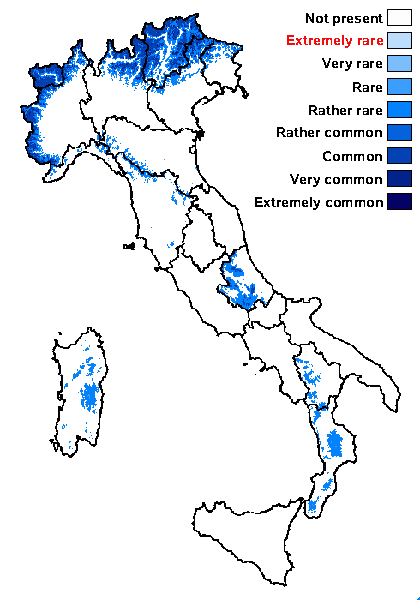
Predictive model
Herbarium samples
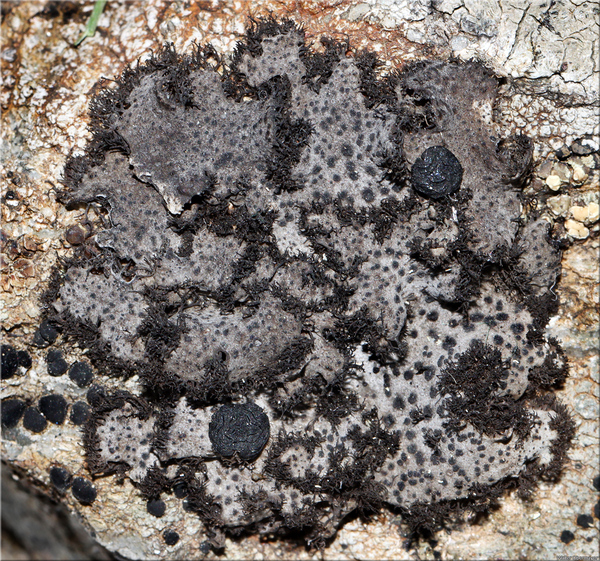
Walter Obermayer CC BY-SA 4.0 - Source: Lichens of Noricum - http://lichens-of-noricum.uni-graz.at/
Austria, Zirbitz
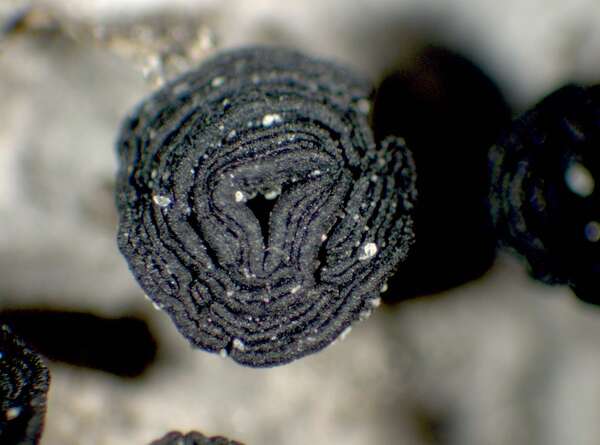

P.L. Nimis; Owner: Department of Life Sciences, University of Trieste
Herbarium: TSB (8311)
2001/12/05
apothecium
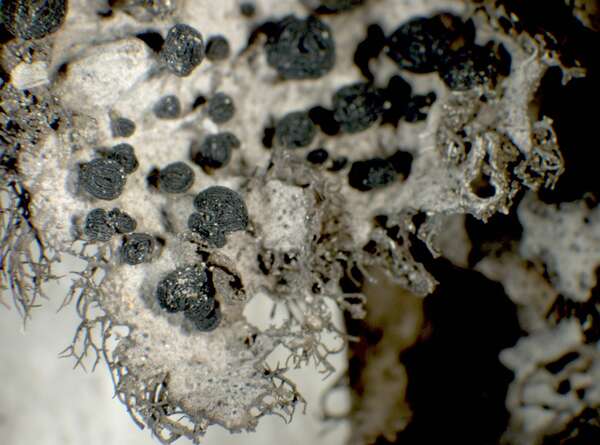

P.L. Nimis; Owner: Department of Life Sciences, University of Trieste
Herbarium: TSB (8311)
2001/12/05
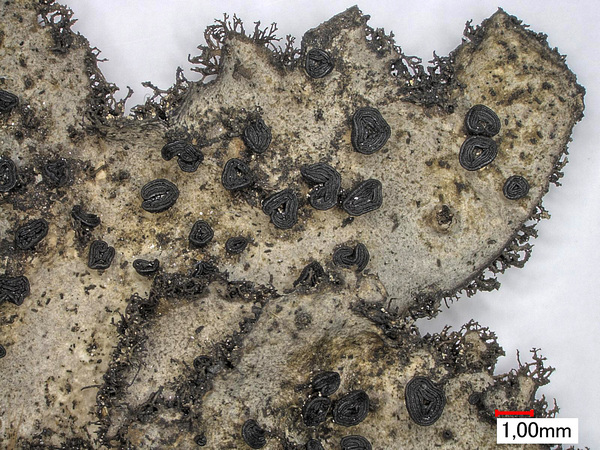

Felix Schumm – CC BY-SA 4.0
[1531], Österreich, Großglockner Hochalpenstraße, auf Silikatgestein, ca. 1800 m. Leg. Schumm 05.08.1969, det. Schumm 1969
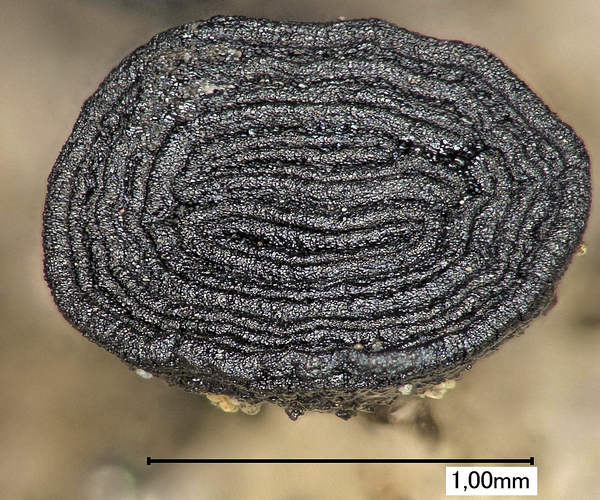

Felix Schumm – CC BY-SA 4.0
[1531], Österreich, Großglockner Hochalpenstraße, auf Silikatgestein, ca. 1800 m. Leg. Schumm 05.08.1969, det. Schumm 1969
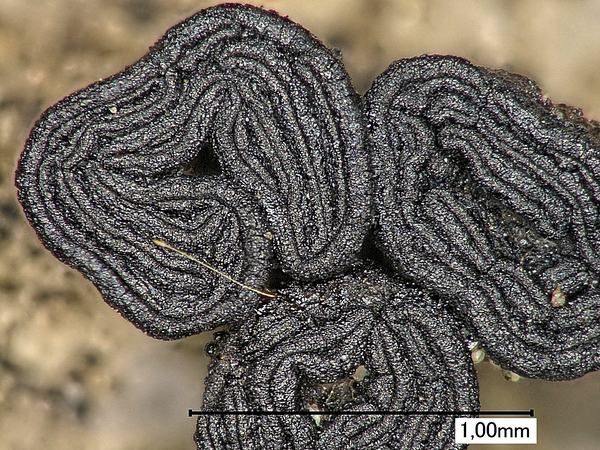

Felix Schumm – CC BY-SA 4.0
[1531], Österreich, Großglockner Hochalpenstraße, auf Silikatgestein, ca. 1800 m. Leg. Schumm 05.08.1969, det. Schumm 1969
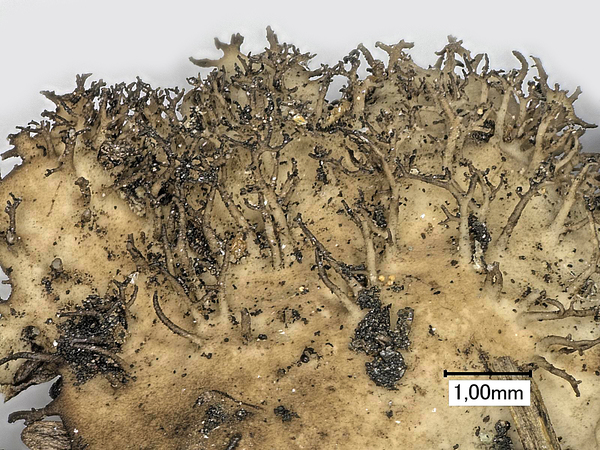

Felix Schumm – CC BY-SA 4.0
[1531], Österreich, Großglockner Hochalpenstraße, auf Silikatgestein, ca. 1800 m. Leg. Schumm 05.08.1969, det. Schumm 1969
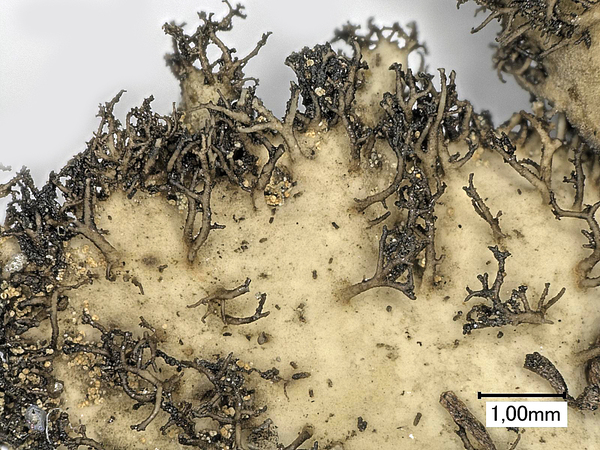

Felix Schumm – CC BY-SA 4.0
[1531], Österreich, Großglockner Hochalpenstraße, auf Silikatgestein, ca. 1800 m. Leg. Schumm 05.08.1969, det. Schumm 1969
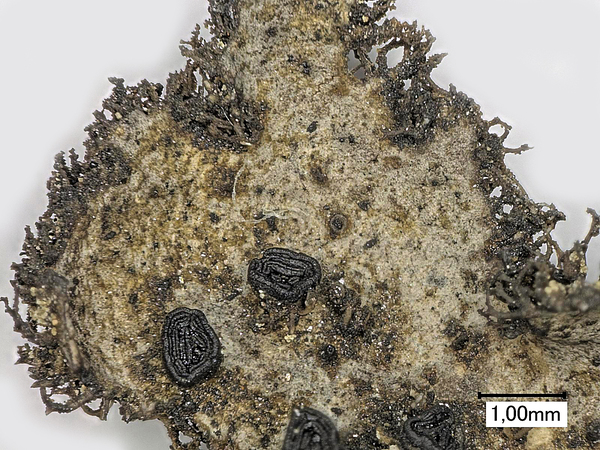

Felix Schumm – CC BY-SA 4.0
[1531], Österreich, Großglockner Hochalpenstraße, auf Silikatgestein, ca. 1800 m. Leg. Schumm 05.08.1969, det. Schumm 1969
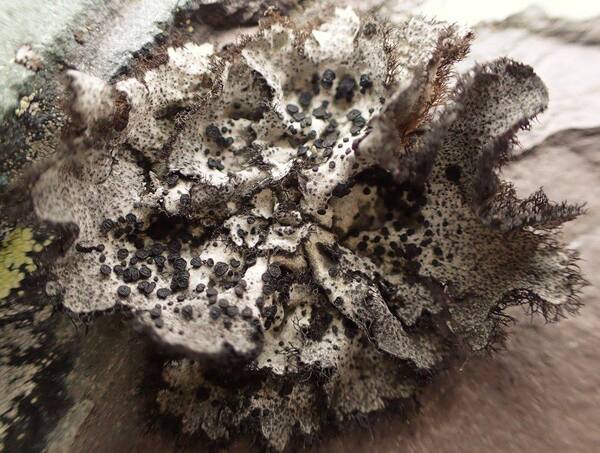

Curtis Randall Björk, - CC BY-SA 4.0
Sugarbowl-Grizzly Den Provincial Park, British Columbia, Canada
August 2017
as v. tilesii
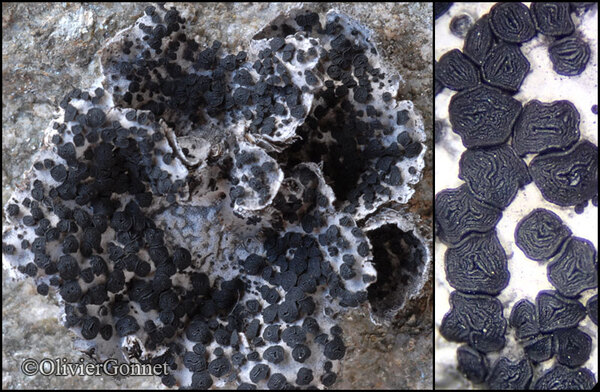
Courtesy Danièle et Olivier Gonnet - Source: https://www.afl-lichenologie.fr/Photos_AFL/Photos_AFL_U/Umbilicaria_cylindrica.htm
France, https://www.afl-lichenologie.fr/Photos_AFL/Photos_AFL_U/Umbilicaria_crustulosa.htm

Courtesy Danièle et Olivier Gonnet - Source: https://www.afl-lichenologie.fr/Photos_AFL/Photos_AFL_U/Umbilicaria_cylindrica.htm
France, https://www.afl-lichenologie.fr/Photos_AFL/Photos_AFL_U/Umbilicaria_crustulosa.htm
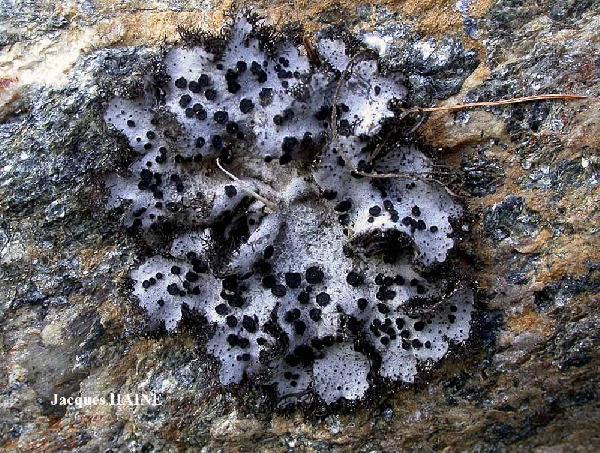
Jacques Haine - Source: http://www.lichensmaritimes.org/index.php?task=fiche&lichen=549&lang=en
Italy, Val d'Aosta
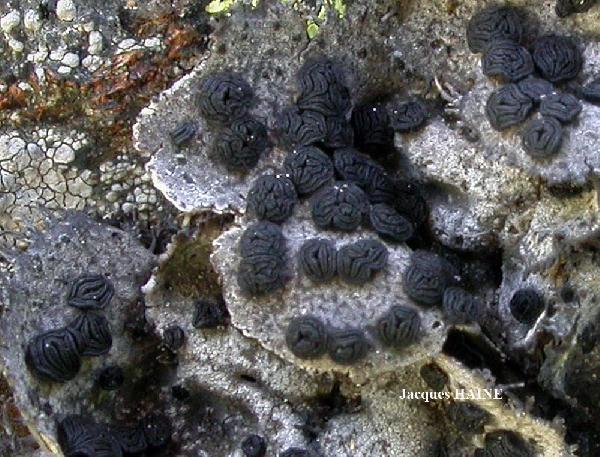
Jacques Haine - Source: http://www.lichensmaritimes.org/index.php?task=fiche&lichen=549&lang=en
Italy, Val d'Aosta

Jacques Haine - Source: http://www.lichensmaritimes.org/index.php?task=fiche&lichen=549&lang=en
Italy, Val d'Aosta
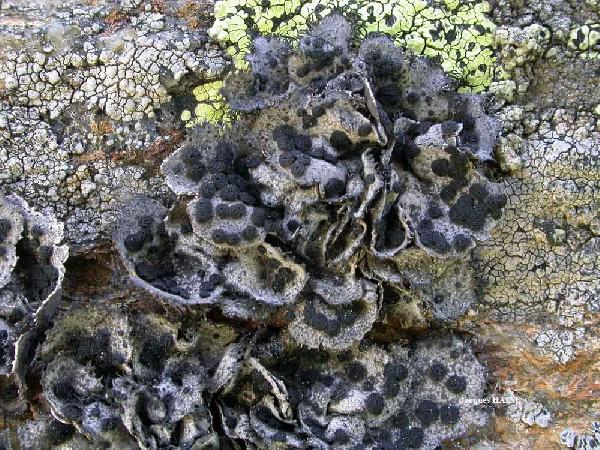
Jacques Haine - Source: http://www.lichensmaritimes.org/index.php?task=fiche&lichen=549&lang=en
Italy, Val d'Aosta
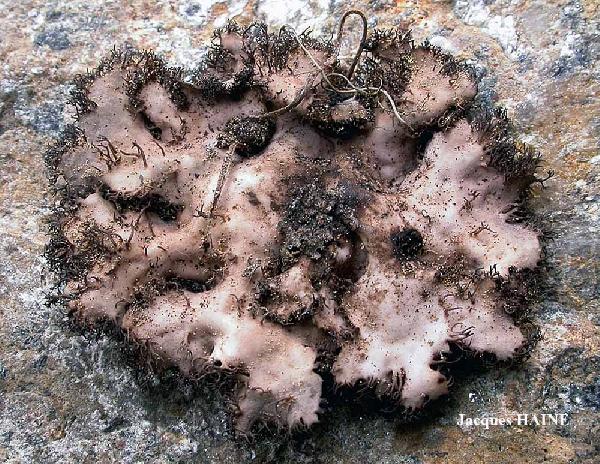
Jacques Haine - Source: http://www.lichensmaritimes.org/index.php?task=fiche&lichen=549&lang=en
Italy, Val d'Aosta
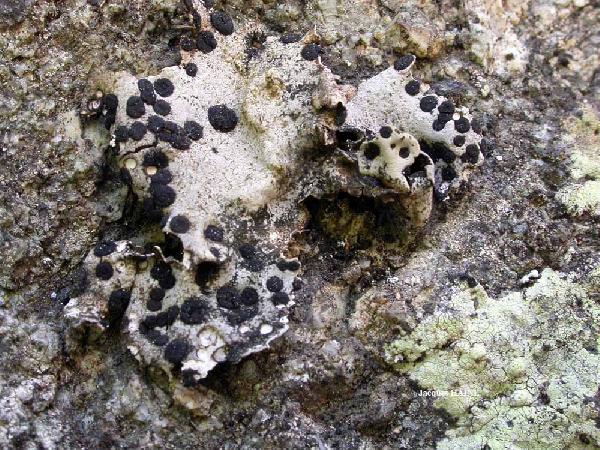
Jacques Haine - Source: http://www.lichensmaritimes.org/index.php?task=fiche&lichen=549&lang=en
France, Mercantour
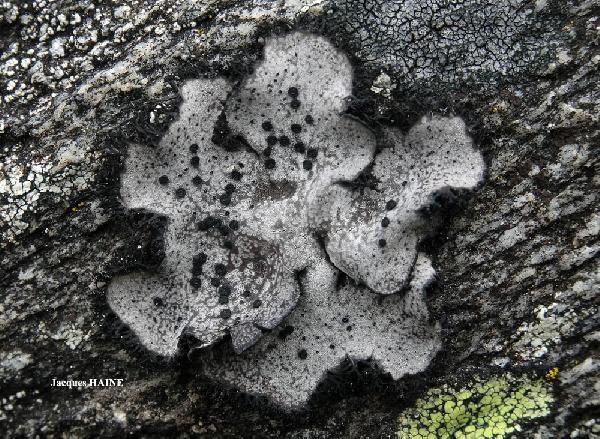
Jacques Haine - Source: http://www.lichensmaritimes.org/index.php?task=fiche&lichen=549&lang=en
France, Tarentaise
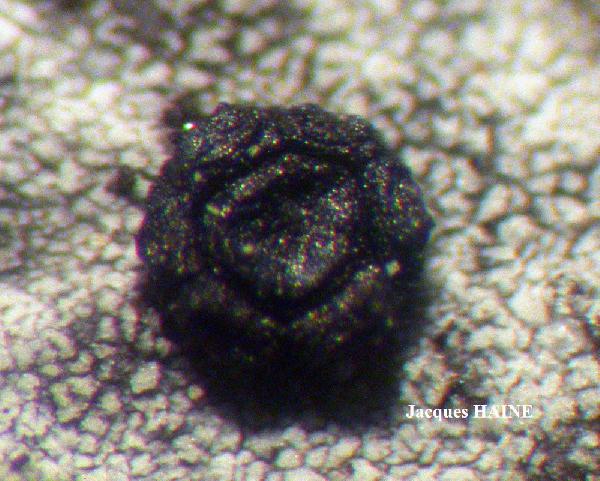
Jacques Haine - Source: http://www.lichensmaritimes.org/index.php?task=fiche&lichen=549&lang=en
France, Tarentaise
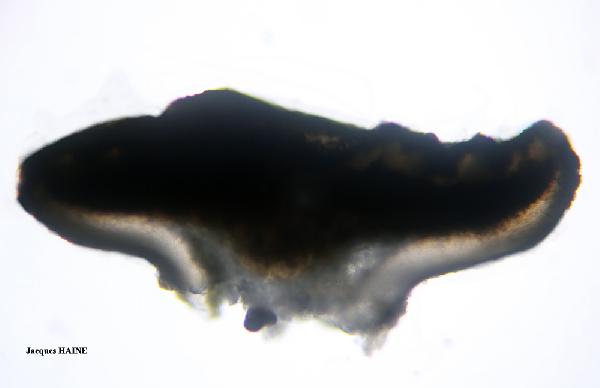
Jacques Haine - Source: http://www.lichensmaritimes.org/index.php?task=fiche&lichen=549&lang=en
France, Tarentaise
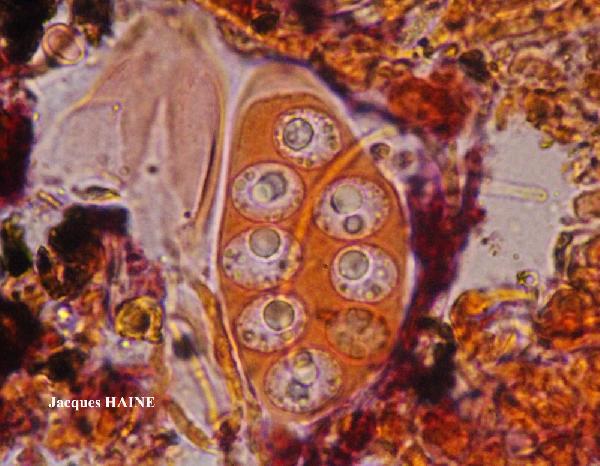
Jacques Haine - Source: http://www.lichensmaritimes.org/index.php?task=fiche&lichen=549&lang=en
France, Tarentaise
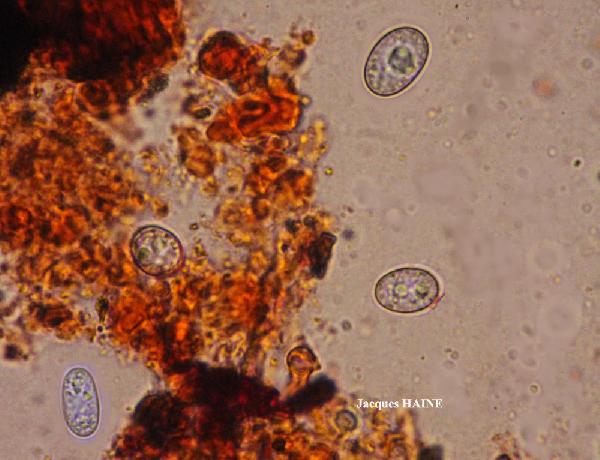
Jacques Haine - Source: http://www.lichensmaritimes.org/index.php?task=fiche&lichen=549&lang=en
France, Tarentaise
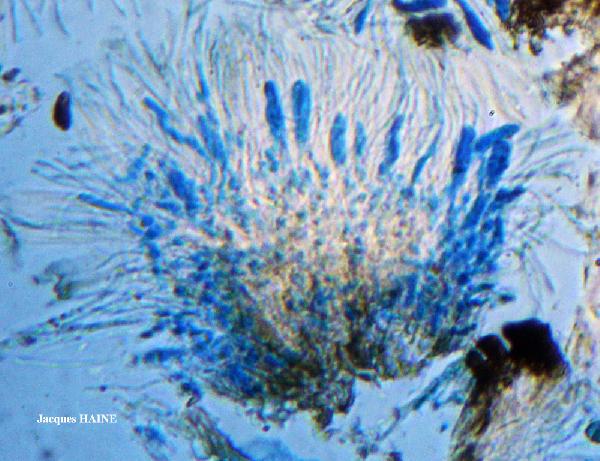
Jacques Haine - Source: http://www.lichensmaritimes.org/index.php?task=fiche&lichen=549&lang=en
France, Tarentaise
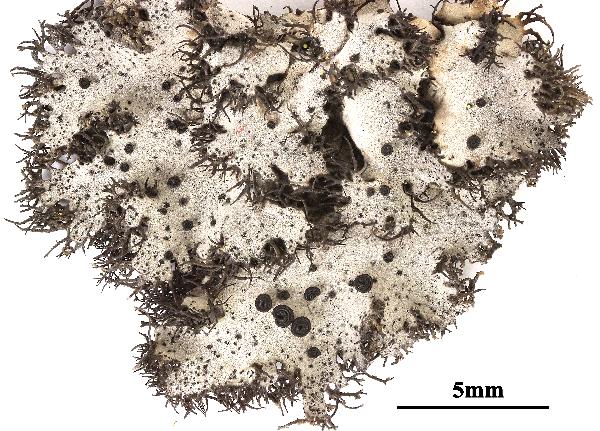

Felix Schumm - CC BY 4.0
[1870], Österreich, Stubaier Alpen, westlich von Innsbruck, zwischen
Sellrain und Kühtai, in einer Wiese an Gneisglimmerblöcken eines
Südhanges, ca. 1300 m. Leg. F. Schumm, 25.07.1971, det. F. Schumm.
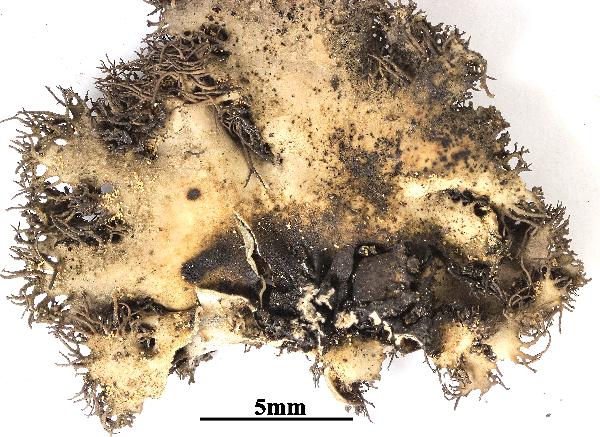

Felix Schumm - CC BY 4.0
[1870], Österreich, Stubaier Alpen, westlich von Innsbruck, zwischen
Sellrain und Kühtai, in einer Wiese an Gneisglimmerblöcken eines
Südhanges, ca. 1300 m. Leg. F. Schumm, 25.07.1971, det. F. Schumm.
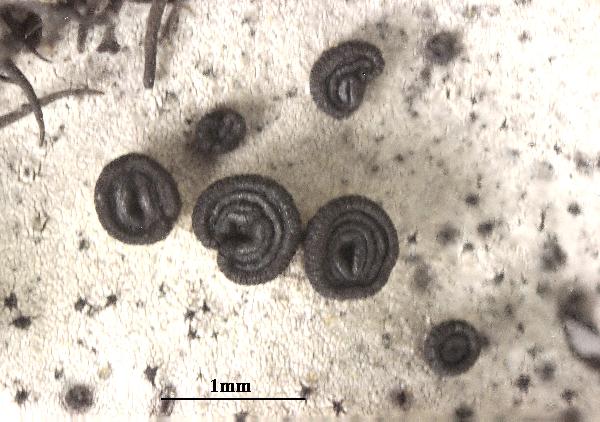

Felix Schumm - CC BY 4.0
[1870], Österreich, Stubaier Alpen, westlich von Innsbruck, zwischen
Sellrain und Kühtai, in einer Wiese an Gneisglimmerblöcken eines
Südhanges, ca. 1300 m. Leg. F. Schumm, 25.07.1971, det. F. Schumm.
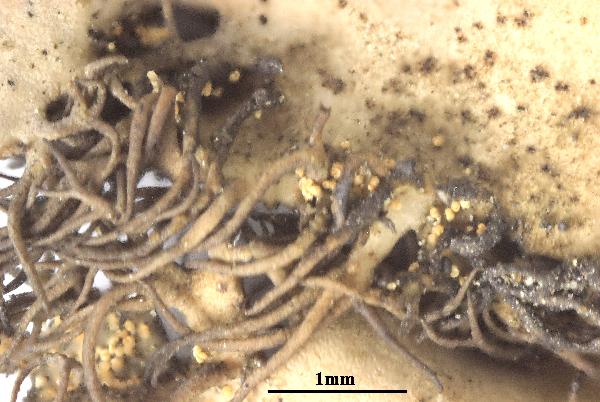

Felix Schumm - CC BY 4.0
[1870], Österreich, Stubaier Alpen, westlich von Innsbruck, zwischen
Sellrain und Kühtai, in einer Wiese an Gneisglimmerblöcken eines
Südhanges, ca. 1300 m. Leg. F. Schumm, 25.07.1971, det. F. Schumm.


Felix Schumm - CC BY 4.0
[20640], Österreich, Lungau, Karneralm, 47°29’89’’ N, 13°47’22.02’’
E, 1900 m, auf Silikatblock. Leg. F. Schumm & U. Schwarz, 2.9.2019.
- Thallus am Rand mit Cilien (gelegentlich auch fast fehlend), ohne
Soredien; Unterseite rhizinenarm, oft etwas rosa getönt, glatt. Apothecien
stark gerillt.


Felix Schumm - CC BY 4.0
[20640], Österreich, Lungau, Karneralm, 47°29’89’’ N, 13°47’22.02’’
E, 1900 m, auf Silikatblock. Leg. F. Schumm & U. Schwarz, 2.9.2019.
- Thallus am Rand mit Cilien (gelegentlich auch fast fehlend), ohne
Soredien; Unterseite rhizinenarm, oft etwas rosa getönt, glatt. Apothecien
stark gerillt.
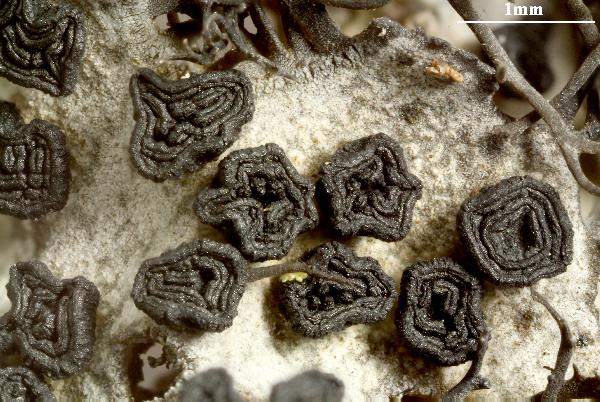

Felix Schumm - CC BY 4.0
[20640], Österreich, Lungau, Karneralm, 47°29’89’’ N, 13°47’22.02’’
E, 1900 m, auf Silikatblock. Leg. F. Schumm & U. Schwarz, 2.9.2019.
- Thallus am Rand mit Cilien (gelegentlich auch fast fehlend), ohne
Soredien; Unterseite rhizinenarm, oft etwas rosa getönt, glatt. Apothecien
stark gerillt.
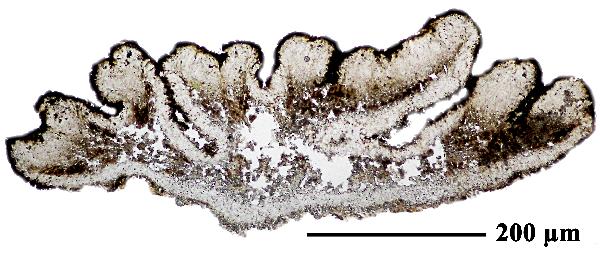

Felix Schumm - CC BY 4.0
[20640], Österreich, Lungau, Karneralm, 47°29’89’’ N, 13°47’22.02’’
E, 1900 m, auf Silikatblock. Leg. F. Schumm & U. Schwarz, 2.9.2019.
- Thallus am Rand mit Cilien (gelegentlich auch fast fehlend), ohne
Soredien; Unterseite rhizinenarm, oft etwas rosa getönt, glatt. Apothecien
stark gerillt.


Felix Schumm - CC BY 4.0
[20640], Österreich, Lungau, Karneralm, 47°29’89’’ N, 13°47’22.02’’
E, 1900 m, auf Silikatblock. Leg. F. Schumm & U. Schwarz, 2.9.2019.
- Thallus am Rand mit Cilien (gelegentlich auch fast fehlend), ohne
Soredien; Unterseite rhizinenarm, oft etwas rosa getönt, glatt. Apothecien
stark gerillt.
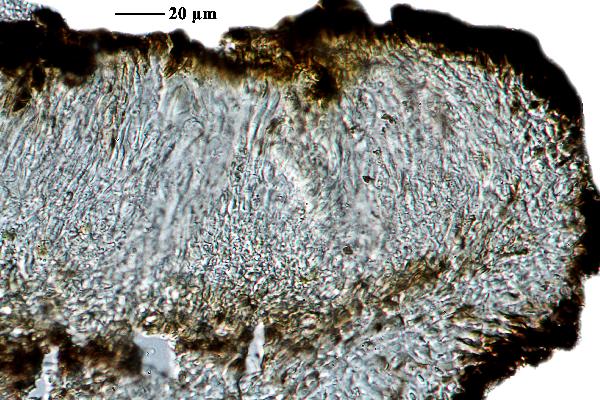

Felix Schumm - CC BY 4.0
[20640], Österreich, Lungau, Karneralm, 47°29’89’’ N, 13°47’22.02’’
E, 1900 m, auf Silikatblock. Leg. F. Schumm & U. Schwarz, 2.9.2019.
- Thallus am Rand mit Cilien (gelegentlich auch fast fehlend), ohne
Soredien; Unterseite rhizinenarm, oft etwas rosa getönt, glatt. Apothecien
stark gerillt.
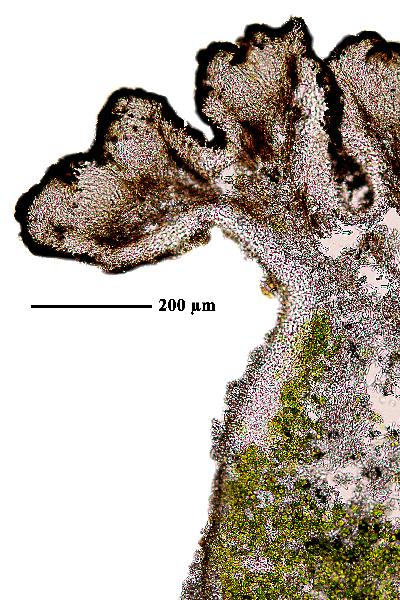

Felix Schumm - CC BY 4.0
[20640], Österreich, Lungau, Karneralm, 47°29’89’’ N, 13°47’22.02’’
E, 1900 m, auf Silikatblock. Leg. F. Schumm & U. Schwarz, 2.9.2019.
- Thallus am Rand mit Cilien (gelegentlich auch fast fehlend), ohne
Soredien; Unterseite rhizinenarm, oft etwas rosa getönt, glatt. Apothecien
stark gerillt.
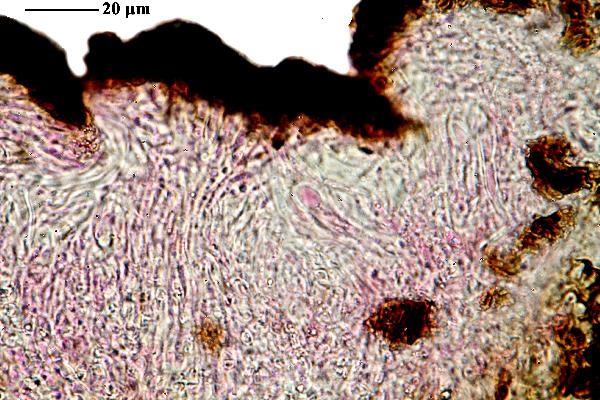

Felix Schumm - CC BY 4.0
[20640], Österreich, Lungau, Karneralm, 47°29’89’’ N, 13°47’22.02’’
E, 1900 m, auf Silikatblock. Leg. F. Schumm & U. Schwarz, 2.9.2019.
- Thallus am Rand mit Cilien (gelegentlich auch fast fehlend), ohne
Soredien; Unterseite rhizinenarm, oft etwas rosa getönt, glatt. Apothecien
stark gerillt.
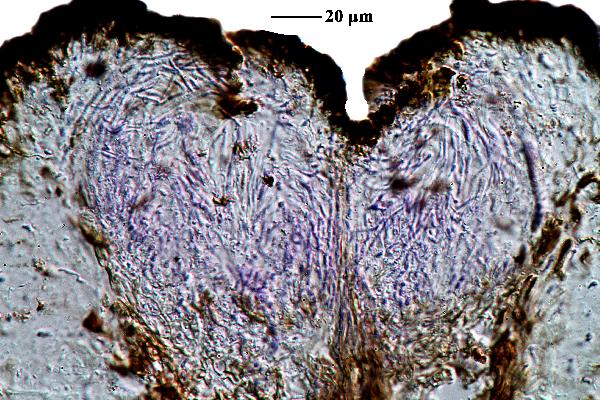

Felix Schumm - CC BY 4.0
[20640], Österreich, Lungau, Karneralm, 47°29’89’’ N, 13°47’22.02’’
E, 1900 m, auf Silikatblock. Leg. F. Schumm & U. Schwarz, 2.9.2019.
- Thallus am Rand mit Cilien (gelegentlich auch fast fehlend), ohne
Soredien; Unterseite rhizinenarm, oft etwas rosa getönt, glatt. Apothecien
stark gerillt.
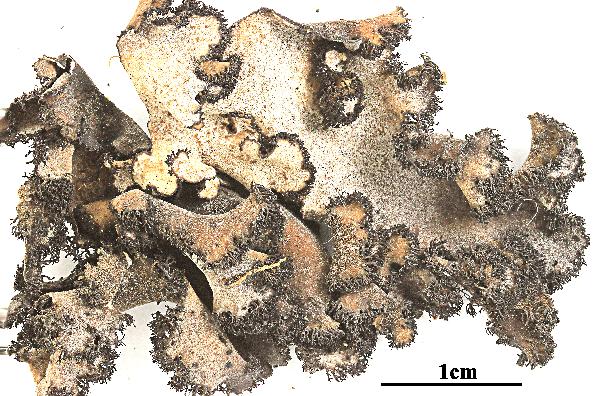

Felix Schumm - CC BY 4.0
[VZ1458], Tanzania (Africa orientalis). Kilimanjaro, prope casam alpinam
Barranco dictam, 3900 m. Ad parietes rupium. Leg. T. Pócs
(6934), 03.07.1976, det A. V zda. EX A. V ZDA: LICHENES SELECTI
EXSICCATI N. 1458.
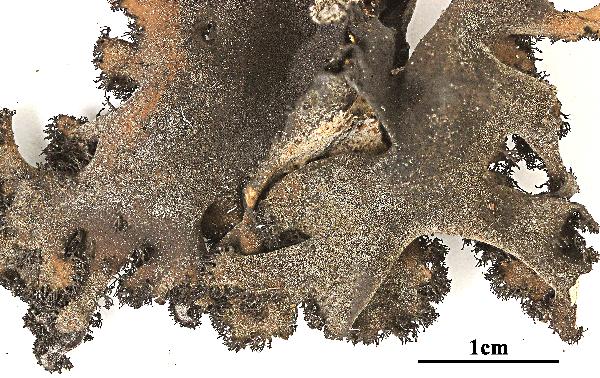

Felix Schumm - CC BY 4.0
[VZ1458], Tanzania (Africa orientalis). Kilimanjaro, prope casam alpinam
Barranco dictam, 3900 m. Ad parietes rupium. Leg. T. Pócs
(6934), 03.07.1976, det A. V zda. EX A. V ZDA: LICHENES SELECTI
EXSICCATI N. 1458.
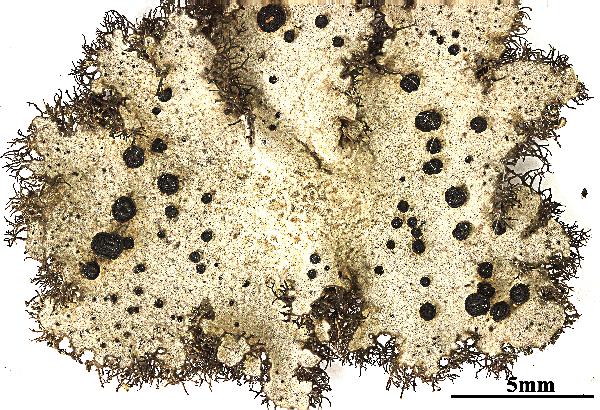

Felix Schumm - CC BY 4.0
[VZ2047], U.R.S.S. Caucasus Magnus, regio montis ignivomi Elbrus,
in valle glaciali Schelda supra oppidum Elbrus, 2000 m. Ad rupes
graniticas. Leg. V. Vašák, 27.06.1980, det. A. V zda. EX A. V ZDA:
LICHENES SELECTI EXSICCATI NR. 2047.
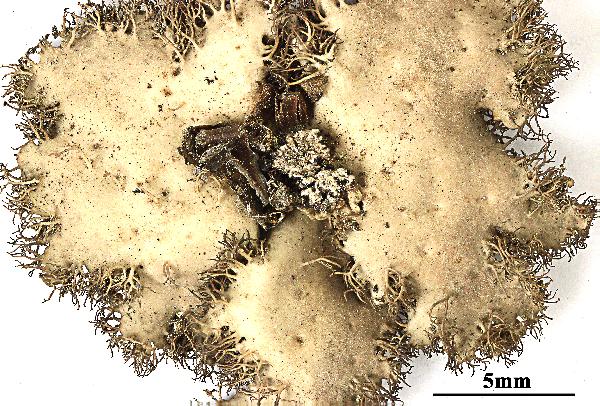

Felix Schumm - CC BY 4.0
[VZ2047], U.R.S.S. Caucasus Magnus, regio montis ignivomi Elbrus,
in valle glaciali Schelda supra oppidum Elbrus, 2000 m. Ad rupes
graniticas. Leg. V. Vašák, 27.06.1980, det. A. V zda. EX A. V ZDA:
LICHENES SELECTI EXSICCATI NR. 2047.
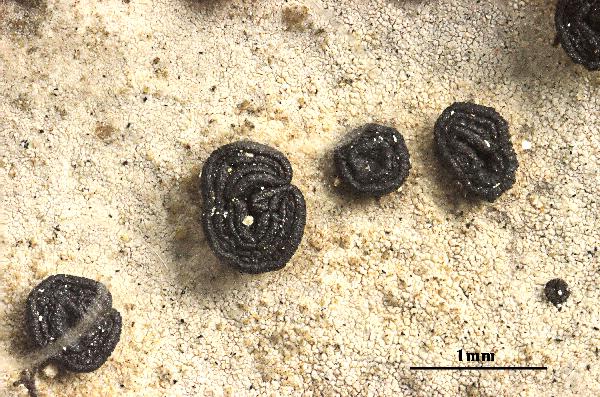

Felix Schumm - CC BY 4.0
[VZ2047], U.R.S.S. Caucasus Magnus, regio montis ignivomi Elbrus,
in valle glaciali Schelda supra oppidum Elbrus, 2000 m. Ad rupes
graniticas. Leg. V. Vašák, 27.06.1980, det. A. V zda. EX A. V ZDA:
LICHENES SELECTI EXSICCATI NR. 2047.
Growth form: Foliose, umbilicate
Substrata: rocks
Photobiont: green algae other than Trentepohlia
Reproductive strategy: mainly sexual
Commonnes-rarity: (info)
Alpine belt: common
Subalpine belt: very common
Oromediterranean belt: rare
Montane belt: rather rare
Submediterranean belt: absent
Padanian area: absent
Humid submediterranean belt: absent
Humid mediterranean belt: absent
Dry mediterranean belt: absent

Predictive model
| Herbarium samples |

Walter Obermayer CC BY-SA 4.0 - Source: Lichens of Noricum - http://lichens-of-noricum.uni-graz.at/
Austria, Zirbitz


P.L. Nimis; Owner: Department of Life Sciences, University of Trieste
Herbarium: TSB (8311)
2001/12/05
apothecium


P.L. Nimis; Owner: Department of Life Sciences, University of Trieste
Herbarium: TSB (8311)
2001/12/05


Felix Schumm – CC BY-SA 4.0
[1531], Österreich, Großglockner Hochalpenstraße, auf Silikatgestein, ca. 1800 m. Leg. Schumm 05.08.1969, det. Schumm 1969


Felix Schumm – CC BY-SA 4.0
[1531], Österreich, Großglockner Hochalpenstraße, auf Silikatgestein, ca. 1800 m. Leg. Schumm 05.08.1969, det. Schumm 1969


Felix Schumm – CC BY-SA 4.0
[1531], Österreich, Großglockner Hochalpenstraße, auf Silikatgestein, ca. 1800 m. Leg. Schumm 05.08.1969, det. Schumm 1969


Felix Schumm – CC BY-SA 4.0
[1531], Österreich, Großglockner Hochalpenstraße, auf Silikatgestein, ca. 1800 m. Leg. Schumm 05.08.1969, det. Schumm 1969


Felix Schumm – CC BY-SA 4.0
[1531], Österreich, Großglockner Hochalpenstraße, auf Silikatgestein, ca. 1800 m. Leg. Schumm 05.08.1969, det. Schumm 1969


Felix Schumm – CC BY-SA 4.0
[1531], Österreich, Großglockner Hochalpenstraße, auf Silikatgestein, ca. 1800 m. Leg. Schumm 05.08.1969, det. Schumm 1969


Curtis Randall Björk, - CC BY-SA 4.0
Sugarbowl-Grizzly Den Provincial Park, British Columbia, Canada
August 2017
as v. tilesii

Courtesy Danièle et Olivier Gonnet - Source: https://www.afl-lichenologie.fr/Photos_AFL/Photos_AFL_U/Umbilicaria_cylindrica.htm
France, https://www.afl-lichenologie.fr/Photos_AFL/Photos_AFL_U/Umbilicaria_crustulosa.htm

Courtesy Danièle et Olivier Gonnet - Source: https://www.afl-lichenologie.fr/Photos_AFL/Photos_AFL_U/Umbilicaria_cylindrica.htm
France, https://www.afl-lichenologie.fr/Photos_AFL/Photos_AFL_U/Umbilicaria_crustulosa.htm

Jacques Haine - Source: http://www.lichensmaritimes.org/index.php?task=fiche&lichen=549&lang=en
Italy, Val d'Aosta

Jacques Haine - Source: http://www.lichensmaritimes.org/index.php?task=fiche&lichen=549&lang=en
Italy, Val d'Aosta

Jacques Haine - Source: http://www.lichensmaritimes.org/index.php?task=fiche&lichen=549&lang=en
Italy, Val d'Aosta

Jacques Haine - Source: http://www.lichensmaritimes.org/index.php?task=fiche&lichen=549&lang=en
Italy, Val d'Aosta

Jacques Haine - Source: http://www.lichensmaritimes.org/index.php?task=fiche&lichen=549&lang=en
Italy, Val d'Aosta

Jacques Haine - Source: http://www.lichensmaritimes.org/index.php?task=fiche&lichen=549&lang=en
France, Mercantour

Jacques Haine - Source: http://www.lichensmaritimes.org/index.php?task=fiche&lichen=549&lang=en
France, Tarentaise

Jacques Haine - Source: http://www.lichensmaritimes.org/index.php?task=fiche&lichen=549&lang=en
France, Tarentaise

Jacques Haine - Source: http://www.lichensmaritimes.org/index.php?task=fiche&lichen=549&lang=en
France, Tarentaise

Jacques Haine - Source: http://www.lichensmaritimes.org/index.php?task=fiche&lichen=549&lang=en
France, Tarentaise

Jacques Haine - Source: http://www.lichensmaritimes.org/index.php?task=fiche&lichen=549&lang=en
France, Tarentaise

Jacques Haine - Source: http://www.lichensmaritimes.org/index.php?task=fiche&lichen=549&lang=en
France, Tarentaise


Felix Schumm - CC BY 4.0
[1870], Österreich, Stubaier Alpen, westlich von Innsbruck, zwischen Sellrain und Kühtai, in einer Wiese an Gneisglimmerblöcken eines Südhanges, ca. 1300 m. Leg. F. Schumm, 25.07.1971, det. F. Schumm.


Felix Schumm - CC BY 4.0
[1870], Österreich, Stubaier Alpen, westlich von Innsbruck, zwischen Sellrain und Kühtai, in einer Wiese an Gneisglimmerblöcken eines Südhanges, ca. 1300 m. Leg. F. Schumm, 25.07.1971, det. F. Schumm.


Felix Schumm - CC BY 4.0
[1870], Österreich, Stubaier Alpen, westlich von Innsbruck, zwischen Sellrain und Kühtai, in einer Wiese an Gneisglimmerblöcken eines Südhanges, ca. 1300 m. Leg. F. Schumm, 25.07.1971, det. F. Schumm.


Felix Schumm - CC BY 4.0
[1870], Österreich, Stubaier Alpen, westlich von Innsbruck, zwischen Sellrain und Kühtai, in einer Wiese an Gneisglimmerblöcken eines Südhanges, ca. 1300 m. Leg. F. Schumm, 25.07.1971, det. F. Schumm.


Felix Schumm - CC BY 4.0
[20640], Österreich, Lungau, Karneralm, 47°29’89’’ N, 13°47’22.02’’ E, 1900 m, auf Silikatblock. Leg. F. Schumm & U. Schwarz, 2.9.2019. - Thallus am Rand mit Cilien (gelegentlich auch fast fehlend), ohne Soredien; Unterseite rhizinenarm, oft etwas rosa getönt, glatt. Apothecien stark gerillt.


Felix Schumm - CC BY 4.0
[20640], Österreich, Lungau, Karneralm, 47°29’89’’ N, 13°47’22.02’’ E, 1900 m, auf Silikatblock. Leg. F. Schumm & U. Schwarz, 2.9.2019. - Thallus am Rand mit Cilien (gelegentlich auch fast fehlend), ohne Soredien; Unterseite rhizinenarm, oft etwas rosa getönt, glatt. Apothecien stark gerillt.


Felix Schumm - CC BY 4.0
[20640], Österreich, Lungau, Karneralm, 47°29’89’’ N, 13°47’22.02’’ E, 1900 m, auf Silikatblock. Leg. F. Schumm & U. Schwarz, 2.9.2019. - Thallus am Rand mit Cilien (gelegentlich auch fast fehlend), ohne Soredien; Unterseite rhizinenarm, oft etwas rosa getönt, glatt. Apothecien stark gerillt.


Felix Schumm - CC BY 4.0
[20640], Österreich, Lungau, Karneralm, 47°29’89’’ N, 13°47’22.02’’ E, 1900 m, auf Silikatblock. Leg. F. Schumm & U. Schwarz, 2.9.2019. - Thallus am Rand mit Cilien (gelegentlich auch fast fehlend), ohne Soredien; Unterseite rhizinenarm, oft etwas rosa getönt, glatt. Apothecien stark gerillt.


Felix Schumm - CC BY 4.0
[20640], Österreich, Lungau, Karneralm, 47°29’89’’ N, 13°47’22.02’’ E, 1900 m, auf Silikatblock. Leg. F. Schumm & U. Schwarz, 2.9.2019. - Thallus am Rand mit Cilien (gelegentlich auch fast fehlend), ohne Soredien; Unterseite rhizinenarm, oft etwas rosa getönt, glatt. Apothecien stark gerillt.


Felix Schumm - CC BY 4.0
[20640], Österreich, Lungau, Karneralm, 47°29’89’’ N, 13°47’22.02’’ E, 1900 m, auf Silikatblock. Leg. F. Schumm & U. Schwarz, 2.9.2019. - Thallus am Rand mit Cilien (gelegentlich auch fast fehlend), ohne Soredien; Unterseite rhizinenarm, oft etwas rosa getönt, glatt. Apothecien stark gerillt.


Felix Schumm - CC BY 4.0
[20640], Österreich, Lungau, Karneralm, 47°29’89’’ N, 13°47’22.02’’ E, 1900 m, auf Silikatblock. Leg. F. Schumm & U. Schwarz, 2.9.2019. - Thallus am Rand mit Cilien (gelegentlich auch fast fehlend), ohne Soredien; Unterseite rhizinenarm, oft etwas rosa getönt, glatt. Apothecien stark gerillt.


Felix Schumm - CC BY 4.0
[20640], Österreich, Lungau, Karneralm, 47°29’89’’ N, 13°47’22.02’’ E, 1900 m, auf Silikatblock. Leg. F. Schumm & U. Schwarz, 2.9.2019. - Thallus am Rand mit Cilien (gelegentlich auch fast fehlend), ohne Soredien; Unterseite rhizinenarm, oft etwas rosa getönt, glatt. Apothecien stark gerillt.


Felix Schumm - CC BY 4.0
[20640], Österreich, Lungau, Karneralm, 47°29’89’’ N, 13°47’22.02’’ E, 1900 m, auf Silikatblock. Leg. F. Schumm & U. Schwarz, 2.9.2019. - Thallus am Rand mit Cilien (gelegentlich auch fast fehlend), ohne Soredien; Unterseite rhizinenarm, oft etwas rosa getönt, glatt. Apothecien stark gerillt.


Felix Schumm - CC BY 4.0
[VZ1458], Tanzania (Africa orientalis). Kilimanjaro, prope casam alpinam Barranco dictam, 3900 m. Ad parietes rupium. Leg. T. Pócs (6934), 03.07.1976, det A. V zda. EX A. V ZDA: LICHENES SELECTI EXSICCATI N. 1458.


Felix Schumm - CC BY 4.0
[VZ1458], Tanzania (Africa orientalis). Kilimanjaro, prope casam alpinam Barranco dictam, 3900 m. Ad parietes rupium. Leg. T. Pócs (6934), 03.07.1976, det A. V zda. EX A. V ZDA: LICHENES SELECTI EXSICCATI N. 1458.


Felix Schumm - CC BY 4.0
[VZ2047], U.R.S.S. Caucasus Magnus, regio montis ignivomi Elbrus, in valle glaciali Schelda supra oppidum Elbrus, 2000 m. Ad rupes graniticas. Leg. V. Vašák, 27.06.1980, det. A. V zda. EX A. V ZDA: LICHENES SELECTI EXSICCATI NR. 2047.


Felix Schumm - CC BY 4.0
[VZ2047], U.R.S.S. Caucasus Magnus, regio montis ignivomi Elbrus, in valle glaciali Schelda supra oppidum Elbrus, 2000 m. Ad rupes graniticas. Leg. V. Vašák, 27.06.1980, det. A. V zda. EX A. V ZDA: LICHENES SELECTI EXSICCATI NR. 2047.


 INDEX FUNGORUM
INDEX FUNGORUM
 GBIF
GBIF
 DOLICHENS
DOLICHENS


